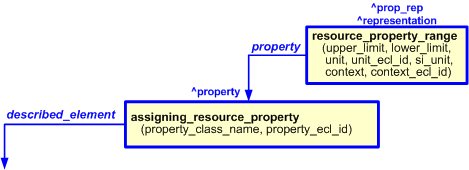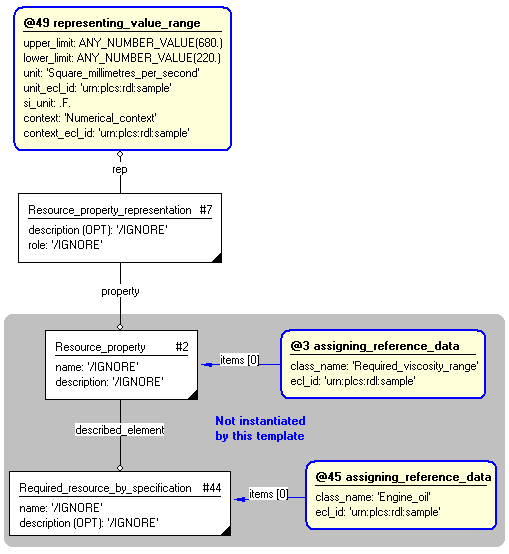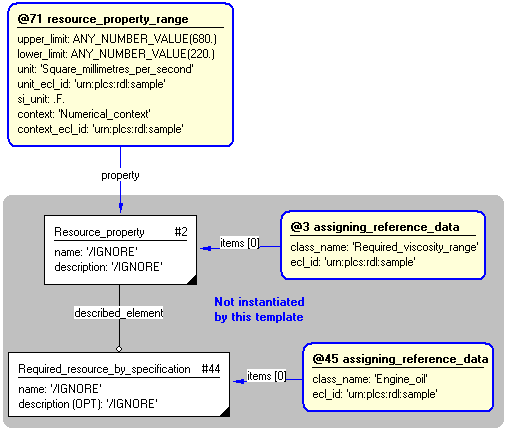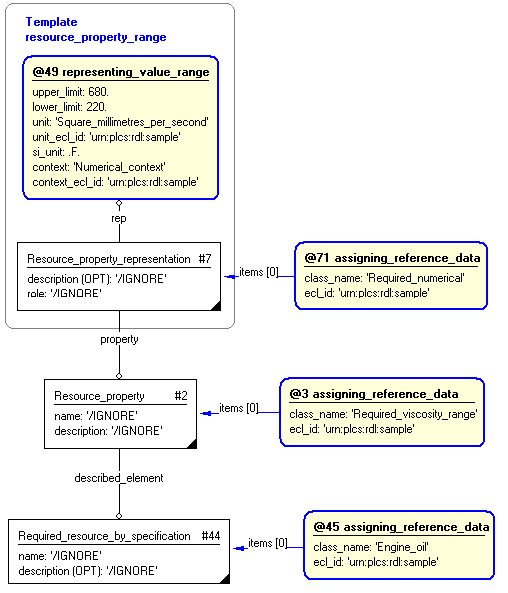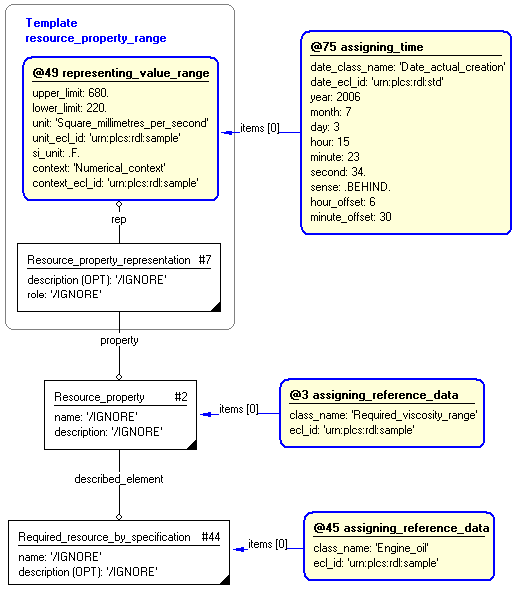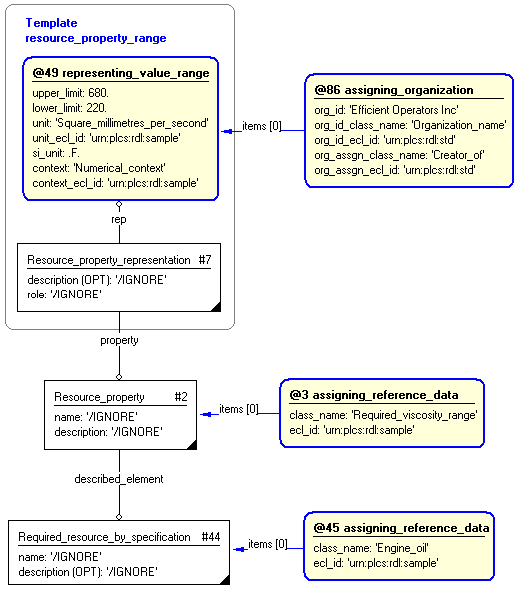| Template:— resource_property_range (res_prp_range) |
Date: 2009/03/24 12:40:22
Revision: 1.19
|
This section specifies the template resource_property_range.
NOTE
An explanation of a template and the associated instantiation path is
provided in the
Template overview
section.
This template describes how to represent a numerical value range for a resource property.
The EXPRESS-G diagram in
Figure
1
shows the templates and EXPRESS entities that are required
to represent the template
"resource_property_range".
The text highlighted in blue shows the template parameters.
Figure 1 — An EXPRESS-G representation of the Information model for resource_property_range
The graphic for the template to be used in other EXPRESS-G diagrams
is shown in Figure
2
below.
Figure 2 —
The graphical representation of resource_property_range template
The graphic for the template to be used in other EXPRESS-G diagrams
is shown in Figure
3
below.
Figure 3 —
The graphical representation of resource_property_range template,
being assigned to template assigning_resource_property
The following input parameters are defined for this template:
The upper limit value of the property.
The datatype is always 'any_number_value'
and should not be registered together with the value, i.e. enter the
value as a number, without datatype.
The lower limit value of the property.
The datatype is always 'any_number_value'
and should not be registered together with the value, i.e. enter the
value as a number, without datatype.
The name of the unit in which the value is expressed, referenced by an
External_class.
The following classes and their sub-classes can be used:
The identifier of the
External_class_library
storing the definition of the unit name referenced by the parameter @unit.
Value should be set to true if the unit is a SI base unit defined by ISO, i.e.
kilogram (kg) for Mass,
second (s) for Time,
metre (m) for Displacement,
ampere (A) for Electrical current,
kelvin (K) for Temperature,
mole (mol) for Amount of substance, and
candela (cd) for Luminous intensity. If this is not the case it should be set to false.
Note that the representation of true and false depends on exchange format. In Part 11 (a STEP file) true is
represented by the string ".T.", and false by ".F.", while in Part 28 (XML) they are represented by text
strings "true"
and "false".
context (Default=Numerical_representation_context,Type='CLASS')
The following classes and their sub-classes can be used:
The identifier of the
External_class_library
storing the definition of the class referenced by the parameter @context.
The following reference parameters are defined for this template:
%^target = $resource_property_range.prop_repr%
%^target = $resource_property_range.representation%
The instantiation path shown below specifies the entities that are to be
instantiated by the template.
A description of templates and the syntax for the instantiation path is
provided in the
Templates Help/Information section.
-- Instantiate Resource_property_representation entity Resource_property_representation-- Bind the Resource_property_representation entity to reference parameter ^prop_repr %^prop_repr =
Resource_property_representation%
-- Set the Property_representation attributes role and description to be ignored
^prop_repr.role = '/IGNORE'
^prop_repr.description = '/IGNORE'
-- Instantiate template representing_value_range /
representing_value_range(
upper_limit=@upper_limit,
lower_limit=@lower_limit,
unit=@unit,
unit_ecl_id=@unit_ecl_id,
si_unit=@si_unit,
context=@context,
context_ecl_id=@context_ecl_id)/
-- Bind the Property_value_representation entity instantiated in the template representing_value_range -- to ^representation in this template and assign Resource_property_representation.rep to it %^representation = $representing_value_range.representation%
^prop_repr.rep ->
^representation
-- Assign value range to property
^prop_repr.property ->
@property
The following entities are instantiated with attributes as specified:
The instance diagram in Figure
4
shows an example of the EXPRESS entities and templates that are instantiated by the template:
/resource_property_range(upper_limit='ANY_NUMBER_VALUE(680)', lower_limit='ANY_NUMBER_VALUE(220)', unit='Square_millimetres_per_second', unit_ecl_id='urn:plcs:rdl:sample', si_unit='false', context='Numerical_context', context_ecl_id='urn:plcs:rdl:sample', property='#2')/
(an illustration of the consolidated resource_property_range template is shown in
Figure
5 below.)
Figure 4 — Entities instantiated by resource_property_range template
The instance diagram in
Figure
5
shows the graphic symbol for the template that is to be
used in other instance diagrams. The example template is:
/resource_property_range(upper_limit='ANY_NUMBER_VALUE(680)', lower_limit='ANY_NUMBER_VALUE(220)', unit='Square_millimetres_per_second', unit_ecl_id='urn:plcs:rdl:sample', si_unit='false', context='Numerical_context', context_ecl_id='urn:plcs:rdl:sample', property='#2')/
Figure 5 — Instantiation of template
The following section details how the
resource_property_range
template can be optionally characterized by assigning
other constructs to it. These are characterizations commonly
applied to the template. The ISO 10303-239 EXPRESS model may enable
other assignments to the entities instantiated by the template.
The following characterizations may apply:
Characterization Assigning representation role
NOTE this characterization is optional.
Characterization Assigning date and time
NOTE this characterization is optional.
Characterization Assigning organization or person
NOTE this characterization is optional.
©
OASIS
2010 — All rights reserved



